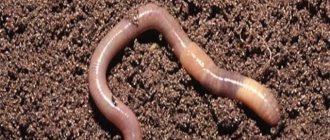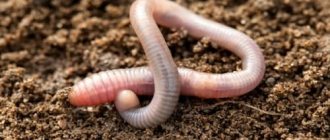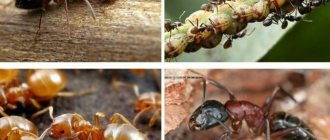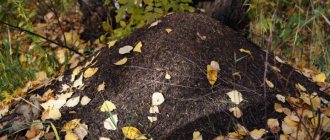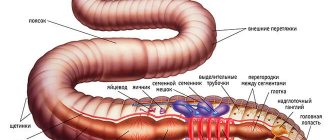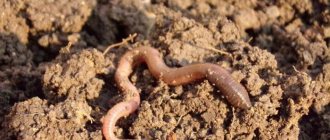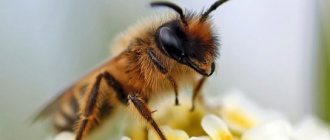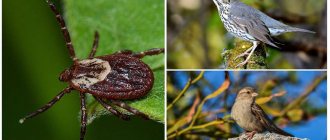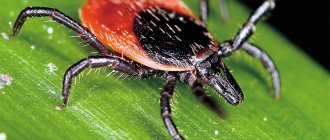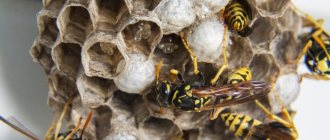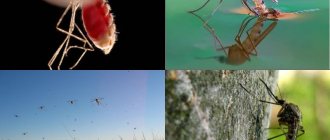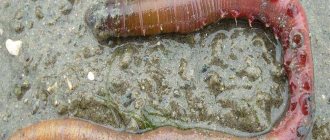Functions of worms in nature
Earthworms are soil invertebrate animals that feed on decaying plant debris. The main importance of worms for the environment is soil formation. Moving in the ground, animals swallow soil particles, rotting organic remains, protozoa, algae, fungi, nematodes, and microbes. After digestion, the mass turns into fairly homogeneous dense lumps - coprolites , which are of great value for supporting life on Earth.
During their life, worms perform many functions:
- loosening the fertile soil layer, due to which its porosity, aeration and drainage are greatly enhanced;
- uniform mixing of soil particles;
- enriching the earth with nutrients, natural antibiotics, enzymes, etc.;
- reduction of pathogenic flora and pest numbers;
- regulation of soil acidity;
- an increase in beneficial microflora, which actively reproduces in excrement and mucus residues on the walls of numerous underground passages of worms;
- reducing erosion by making soils grainier;
- accelerating the processing of rotting organic matter and the like.
Plants are not able to absorb nutrients in any form. In the intestines of worms, matter is completely broken down into elementary particles, which are absorbed by plants instantly. And the lumpy structure of coprolites prevents the leaching and weathering of useful substances from the soil.
The role and importance of worms in nature is not limited to soil formation. Worms are an important link in the food chain, as they are the main food for many animal species.
What are earthworms?
The worm is a tubular digestive system enclosed in a thin shell. Having captured food with the front part of the body, the worm pushes it through itself, digests it, and on the back side of the body releases organic matter, which becomes a source of nutrients for plants - bio-humus. The food for earthworms is wilted leaves, the fibers of which are sufficiently softened, so the chosen habitat is manure heaps consisting of semi-rotted humus, last year's leaves, mown grass, and dried weeds that have lain on the ground for a long time. Worms move deeper into the earth, constantly eating food. They feed on parts of decaying plants and even animal remains. Worms rarely come to the surface; they work underground.
Worms, moving throughout the garden, unlike other insects, do this without legs and wings. They have a muscular body covered with bristles that allow the body to move in the soil. The worm's body is divided into flexible segments. He stretches out strongly, clinging to the ground, and pulls his whole body to a new fulcrum. The movement of the worm is alternate lengthening and contraction of the body. Worms are quite long individuals, reaching up to 30 centimeters in length. The body of the worm is brown or red in color and is clearly visible in the ground when digging. Worms come to the surface of the soil only in rainy weather to find a partner and copulate. Thus, the reproduction of these creeping individuals occurs. It should be noted that during heavy rainfall and severe waterlogging of the soil, the earth becomes quite compacted, which makes it difficult for the worm to breathe, and it is simply forced to move to the top layer of soil, or even go outside to receive another portion of oxygen.
Worms live in damp places due to their special way of breathing. Earthworms have neither lungs nor gills; they absorb air through their skin, so their skin is very thin and always moist. Worms cannot stay on the surface for a long time, where it is dry and hot, since their skin quickly dries out and the creeping creature, so useful for garden plants and soil, dies.
The benefits of worms for humans
Until now, no more effective way of restoring eroded, depleted or contaminated soils has been invented than breeding earthworms. Vermicultivation (growing invertebrates in captivity) makes it possible to produce vermicompost on an industrial scale and enrich large areas of land with it.
Summer residents do not have to propagate vermiculture artificially. Having assessed the importance of worms in agriculture, a farmer can attract worms to his plot in the following ways:
- avoid deep plowing (it is better to dig or loosen with a flat cutter);
- mulch the surface to avoid drying out of the soil and sudden temperature changes;
- leave a minimum area of the site without planting (vegetation prevents moisture evaporation);
- in the fall, leave some plant debris on the beds (worms need food);
- reduce the use of chemicals;
- annually add compost or humus as fertilizer;
- Do not burn plant waste, but compost it and subsequently add it to the soil (especially since worms do not like excess ash).
Breeding worms on the site also has a side effect - the abundance of invertebrates attracts moles. Vermicultivation in closed containers will help avoid this. As a useful product, the farmer will receive not only vermicompost , but also worm biomass for feeding livestock or selling.
What is vermicompost and how is it useful?
Vermicompost is an organic fertilizer that people obtain as a result of processing organic waste with the help of earthworms and beneficial microorganisms.
The use of such natural fertilizer on the site helps solve the following problems:
- reduce the number of pests and weeds on the site;
- bind heavy metal residues and remove residual radiation;
- get a generous and high-quality harvest without the use of chemical fertilizers.
The influence of worms on the environment
Soil without earthworms becomes compacted, depleted, and susceptible to water and wind erosion. Its structure and biochemical composition deteriorate, and the development of beneficial microflora slows down. Accordingly, vegetation gradually becomes sparse and stunted, and living conditions for other underground and terrestrial organisms worsen.
The role and importance of worms in nature as orderlies is great. The bulk of organic remains are utilized by worms. Microorganisms cannot cope with a large volume of garbage, so the fewer invertebrates in the soil, the more favorable the environment for the development of putrefactive flora and parasites.
Humus (the active part of soils, a product of organic matter decomposition) is necessary to maintain the environment, since it:
- has the nutritional properties necessary for flora;
- gives plants immunity;
- binds and neutralizes dangerous chemical compounds and so on.
The main suppliers of humus are worms, since their excrement (vermicompost) is superior in nutritional value to other natural fertilizers. Over the course of a year, 50-120 tons of coprolites are formed per hectare of soil, which creates favorable conditions for the existence of living organisms.
The role of earthworms in changing and improving soil properties
The purpose of this work is to identify the main role of earthworms in changing and improving soil properties. The relevance of this topic is determined by the fact that there is a threat of a decrease in earthworm populations.
Even despite their large numbers, and with intensive reproduction. This is due to anthropological influence, for example, in cities, automobile infrastructure has a great influence. Pesticides are used in agriculture. The scientific novelty lies in the use of earthworms as biotests. However, today this test is not included in the list of tests used for the toxicological assessment of pesticides because they are the animals most sensitive to polluting components. Scientists' experiments show that without earthworms, fallen above-ground parts of plants decompose 2-3 times slower. Numerous vegetation experiments show that in the presence of earthworms, the yield of various field crops increases, for example, barley by 50-100%, oats by 200%. Earthworms “supply” the soil with beneficial microorganisms, and plant roots more easily penetrate into the depths along their passages.
According to the observations of Charles Darwin, worms in fields bring about 0.5 cm of soil to the surface per year, which is approximately 0.5 m per century. This entire layer is passed through the intestines of earthworms. Over the course of a year, worms carry out 2.5 kg of soil per square meter of surface, and about 38 tons per hectare of meadow soil.
The average number of worms in garden soil, according to the observations of one German scientist, is 13 individuals per 1 m2. According to other calculations, in deciduous forests there are at least 300 thousand of them per hectare of area. With 7-8 individuals per 1 m2 per year on one hectare of forest soil, worms can process up to 250 kg of fallen leaves and other parts of plants. Thus, over a relatively short period of time, the entire surface layer of soil passes through the intestines of earthworms more than once, as a result of which it is loosened and mixed with plant debris.
Experiments have shown that the role of earthworms in changing and improving the properties of the soil is much greater than loosening and mixing its layers during plowing. Worms mix the soil to a greater depth than a plow. Species of worms such as the European “Lumbricus terrestris”, or the large Caucasian species “Dendrobaena muriupolienis”, which spreads in the steppe zone, go into the soil 2 m and deeper, introducing plant remains into the parent rock, and this contributes to an increase in the fertile humus layer. Earthworm passages create the so-called non-capillary porosity of the soil, which improves its aeration and such agronomically important properties as water permeability and drainage.
During the dry season, in places with insufficient soil moisture, the worms sink to a considerable depth. Thus, these animals play an extremely important role in nature - they continuously cultivate and improve the soil, increasing its fertility. There are a number of observations showing that when earthworms were moved to fields where they were not previously present, it was possible to increase the yield of rye, turnips, rapeseed and potatoes by 50-100%.
In the forest, the number of earthworms varies greatly depending on the composition of the soil and the nature of the tree stand; in a deciduous forest there are 200-500 individuals per 1 m2, in coniferous forests there are up to 100 individuals.
In forestry, when growing various crops, the presence of worms in the soil is taken into account, since they serve as an indicator of the degree of its acidity. Slightly acidic soils are favorable for the life of worms, but they cannot exist in more acidic soil.
The enormous transformative activity of earthworms makes them desirable settlers on all soils. Different types of them are characterized by varying degrees of participation in individual stages of soil formation and are differently demanding of certain environmental conditions.
The huge amount of chemicals used in agriculture in the form of pesticides, herbicides and fertilizers, as well as industrial emissions from enterprises, have led to significant environmental pollution. Considering that every year dozens of new substances that are not characteristic of living nature are developed and then produced in the world, it is completely impossible to predict their toxic effects on the environment and humans. Therefore, the issues of comprehensive study of environmental ecology are particularly acute.
Traditionally, chemical analytical methods are used for environmental and toxicological assessment of territories. They provide a kind of “snapshot” of the picture of contamination of certain objects (water, soil, bottom sediments, etc.) with specific toxicants. However, they cannot reflect the state of the ecosystem as a whole, assess the entire range of pollutants and their interaction with each other (the “cocktail” effect). In addition, the big disadvantages of these methods are their high labor intensity and the need to purchase high-precision, expensive analytical equipment. At the same time, identifying the spectrum of pollutants in environmental components often does not allow us to judge their toxicity for warm-blooded animals and humans. For many chemicals, hygienic standards have not been developed (maximum permissible concentrations, threshold doses, etc.), by which the degree of exposure to humans can be assessed. For an integral assessment of the impact of pollutants on agrocenoses, biological methods using specially selected animal biotests are more applicable.
Biotesting makes it possible to determine the integral toxicity of samples from the analyzed territories, to assess the ecological and toxicological state of agrocenoses and the possible impact on humans.
The essence of this method is to determine the effect of toxicants on specially selected organisms under standard conditions, recording various behavioral, physiological or biochemical indicators. Biotesting is widely used to control the quality of natural and toxic wastewater, when conducting environmental assessment of new wastewater treatment technologies, and to substantiate standards for maximum permissible concentrations of polluting components.
Test animals are usually selected from among the species most sensitive to pollutants. Another important requirement is that exposure of the animal to the toxicant must cause a response. Knowledge of the mechanisms of specific toxic effects allows us to weaken or enhance the effect of the toxicant using specially selected pharmacological agents. If the latter have selectivity, then in some cases it becomes possible, using test objects, not only to detect a toxic effect, but also to make a group identification of the toxicant. Enhancing the effect with the help of pharmacological agents makes it possible to reduce the detection threshold of a toxicant without resorting to its concentration (a technique common in instrumental physicochemical analysis of impurities).
For biotesting of soil samples, earthworms, oligochaetes (ringed worms) and various insects are most often used. According to ecotoxicologists, the reproductive test is top of the list recommended for soil assessment.
Biotesting is carried out to determine the integral toxicity of soil in order to verify compliance of soil quality with regulatory requirements. The soil being tested should not have an acute or chronic toxic effect on the test objects.
The method of biotesting on earthworms acquires great importance when assessing the results of reclamation (bioremediation) of areas contaminated with toxic chemicals. Biotesting makes it possible to quickly and effectively assess the integral toxicity of soil before, during and after bioremediation, evaluate the effectiveness of bioremediation technology, and also show that the decomposition products of pollutants are of low toxicity to the environment. This provides operational control over the environmental safety of technologies used for bioremediation.
An equally important aspect of using earthworms as biotests could be the choice of the least toxic pesticides, which, unfortunately, modern agriculture cannot yet abandon. However, today this test is not included in the list of tests used in the toxicological assessment of pesticides. Earthworms themselves are victims of pesticide use.
BIBLIOGRAPHY
1 A.B. Georgievsky "Darwinism". M: "Enlightenment". 1985. 269 p.
2 C. Darwin “The Origin of Species by Natural Selection.” M: "Enlightenment". 1987. 384 pp.
3 A.A. Paramonov "Darwinism". M: “Enlightenment” 1978. 354 p.
4 D. Taylor, N. Green, W. Stout “Biology”. In III volume, M: “Mir” 2008.
5 “Animal World”, encyclical in VI volume, volume GU /Invertebrates. Shellfish. Worms. Echinoderms/. M. AST: Gallah Institute. 1998. 184 p.
Vermicompost fertilizer
In order for them to produce humus, they must be collected in one place:
- To do this, it is made in the form of a compost heap up to half a meter high and an area of 1-2 square meters. m., covered with straw, rags or dark film. The compost must be moist. It needs to be watered regularly.
- Then make two holes in the center and pour the prepared worms from a bucket into each, along with the soil in which they lived. Then you level the surface of the pile and cover it again.
- Every other day, moisturize again. For four to five weeks, the worms' home needs only periodic moistening.
- All this time, the worms will lay cocoons, one at a time each for a week. Young worms 4-6 mm long will emerge from laid eggs in two to three weeks, and over the summer the mass of worms increases 20-30 times.
In addition to regularly moistening the bed, it is necessary to increase its surface with a compost layer by 15-20 cm once every two weeks from June to October. At the same time, the height of the heap will increase and to prevent it from falling apart, cover it on the sides with boards. Over the summer, the top layer of the heap will be populated by worms, and the bottom will turn into high-quality vermicompost fertilizer.
